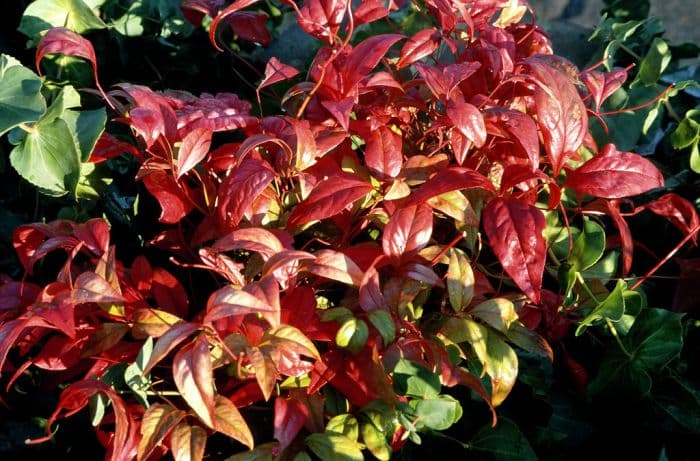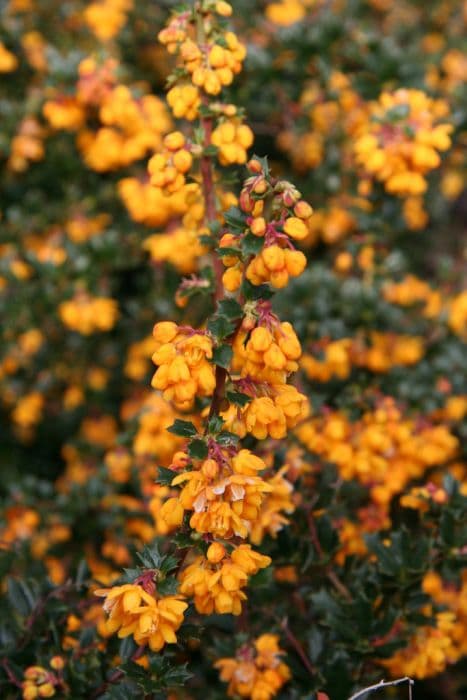Heavenly Bamboo Nandina domestica 'Fire Power'

ABOUT
The 'Fire Power' is a compact and bushy evergreen shrub that showcases an array of striking foliage. The leaves are oval to lance-shaped, providing a fine texture with their delicate appearance. Throughout the year, the leaves exhibit a mix of colors. Spring and summer usher in bright green shades, while cooler months bring a transformation, as the foliage adopts intense hues of red, orange, and sometimes purple, resembling the flickering flames of a fire, hence the name 'Fire Power.' This plant's transition from green to fiery tones is often the most remarkable trait it possesses, especially when the colors peak during the fall and winter. In addition to the vibrant leaves, white flowers may bloom in early summer. Though not the main attraction, these flowers add a subtle touch to the shrub's overall display, giving way to red berries as the seasons progress. The appearance of the 'Fire Power' is characterized by its hearty, lush foliage that provides year-round interest in gardens, making it a popular choice for adding seasonal color.
About this plant
 Names
NamesFamily
Berberidaceae
Synonyms
Fire Power Nandina, Heavenly Bamboo, Sacred Bamboo
Common names
Nandina domestica.
 Toxicity
ToxicityTo humans
Heavenly bamboo is mildly toxic to humans if ingested. It contains compounds that can produce hydrogen cyanide, which, in sufficient amounts, can lead to cyanide poisoning. Symptoms from ingesting parts of the plant, particularly the berries, could include nausea, vomiting, abdominal pain, and difficulty breathing. Severe cases, which are rare, may result in low blood pressure, dizziness, weakness, stupor, and convulsions. It's important to avoid ingesting heavenly bamboo and keep it out of reach of children who might be tempted to eat the berries.
To pets
Heavenly bamboo is also toxic to pets, including dogs, cats, and horses. The plant contains cyanogenic glycosides, which can release cyanide when chewed or digested. Symptoms of toxicity in pets may include drooling, vomiting, diarrhea, weakness, difficulty in breathing, dilated pupils, and seizures. In severe cases, ingestion can lead to coma and even death. It is especially important to monitor pets around this plant and prevent them from ingesting any part of it, particularly the berries.
 Characteristics
CharacteristicsLife cycle
Perennials
Foliage type
Evergreen
Color of leaves
Green
Height
2 feet [0.61 meters]
Spread
2 feet [0.61 meters]
Plant type
Shrub
Hardiness zones
6
Native area
Asia
Benefits
 General Benefits
General Benefits- Year-round Interest: 'Fire Power' (Heavenly Bamboo) has foliage that changes color throughout the seasons, providing visual interest in the garden all year long.
- Low Maintenance: This variety requires minimal care once established, making it suitable for gardeners of all skill levels.
- Compact Size: Its small stature allows it to fit into a variety of landscapes, including smaller gardens or as a container plant.
- Drought Tolerance: Once established, 'Fire Power' is relatively drought-tolerant, requiring less frequent watering than many other plants.
- Pest Resistance: It is typically resistant to pests, reducing the need for chemical treatments.
- Attracts Wildlife: The flowers and berries can attract birds and other wildlife, adding life and interest to the garden.
- Easy Propagation: 'Fire Power' can be easily propagated from cuttings, allowing gardeners to expand their collection without additional cost.
- Versatile Use: It’s well-suited for a variety of landscape uses including as a specimen plant, in mass plantings, or as a hedge.
- Seasonal Berries: It produces bright red berries that can add a splash of color to the winter garden (though berries are more prominent in other varieties).
- Adaptability: 'Fire Power' can adapt to a range of soil types, though it prefers well-drained soils.
 Medical Properties
Medical PropertiesThis plant is not used for medical purposes.
 Air-purifying Qualities
Air-purifying QualitiesThis plant is not specifically known for air purifying qualities.
 Other Uses
Other Uses- Nandina domestica 'Fire Power', commonly known as Heavenly Bamboo, is often used in dried floral arrangements due to its long-lasting vibrant foliage and red berries.
- Heavenly Bamboo can be planted in outdoor pots and containers for winter interest, as it retains its colorful foliage during colder months.
- The dense foliage of Heavenly Bamboo makes it an excellent choice for hiding unsightly objects in the garden like utility boxes or air conditioning units.
- Its striking red and green leaves make Heavenly Bamboo a popular plant for holiday decorating, both indoors and outdoors.
- Heavenly Bamboo is used in bonsai culture, where the plant's woody stems and fine texture can be trained into miniature tree forms.
- The contrasting colors of the foliage of Heavenly Bamboo can be used to create visual depth in garden landscapes when placed behind green-leaved plants.
- Heavenly Bamboo is often planted as part of wildlife-friendly gardens to provide food for birds with its berries.
- Cut stems of Heavenly Bamboo are sometimes used in artisanal crafts, such as handmade wreaths or as part of mixed media artwork.
- The berries of Heavenly Bamboo can be used as a natural dye for fabrics, yielding shades of green and yellow depending on the mordant used.
- Heavenly Bamboo can be used as a natural privacy screen or hedge in landscaping due to its thick and bushy growth habit.
Interesting Facts
 Feng Shui
Feng ShuiThe Fire Power Nandina is not used in Feng Shui practice.
 Zodiac Sign Compitability
Zodiac Sign CompitabilityThe Fire Power Nandina is not used in astrology practice.
 Plant Symbolism
Plant Symbolism- Transformation: The 'Fire Power' Nandina, also known as Heavenly Bamboo, changes color throughout the seasons, symbolizing the transformation and adaptability of nature.
- Protection: In some cultures, Nandina is believed to ward off negative energies, and its presence is thought to protect a home from evil spirits.
- Longevity: Heavenly Bamboo is an evergreen plant, making it a symbol of long life and endurance due to its year-round presence.
- Prosperity: With its lush greenery and vibrant colors, it is often associated with growth and prosperity.
 Water
WaterHeavenly Bamboo should be watered deeply, allowing the soil to dry slightly between watering sessions. On average, provide it with about 1 inch of water per week, although this amount will vary with local weather conditions – more during hot, dry periods and less during rainy spells or cooler temperatures. For smaller plants, this typically means about a half-gallon per plant, while larger shrubs may need several gallons. Adjust watering frequency based on the plant’s response and the soil moisture level, as overwatering can lead to root rot.
 Light
LightHeavenly Bamboo thrives best in full sun to partial shade. The ideal spot for this plant would receive at least 4 to 6 hours of direct sunlight per day, which encourages the best leaf coloration and growth habit. However, it can also tolerate and remain healthy in locations with dappled sunlight or light shade, especially in hotter climates.
 Temperature
TemperatureHeavenly Bamboo prefers a temperature range between 10 to 85 degrees Fahrenheit for optimal growth. It can survive minimum temperatures down to around 0 degrees Fahrenheit but may experience some foliage damage. The ideal conditions would be a moderately temperate climate without prolonged periods of extreme heat or cold.
 Pruning
PruningHeavenly Bamboo rarely requires pruning, but selective trimming can be done to maintain its shape or remove any dead or damaged branches. The best time for pruning is in late winter or early spring before new growth begins. Prune sparingly to encourage denser foliage, and always use clean, sharp tools to avoid damaging the plant. Regular removal of spent flowers or berries is not necessary but can be done for aesthetic reasons.
 Cleaning
CleaningAs needed
 Soil
Soil'Fire Power' Nandina, also known as Heavenly Bamboo, thrives best in a well-draining, loamy soil mix with a slightly acidic to neutral pH of 6.0 to 7.0. A mixture of two parts garden soil, one part peat moss, and one part perlite or sand enhances drainage and aeration.
 Repotting
RepottingHeavenly Bamboo ('Fire Power' Nandina) typically needs repotting every 2 to 3 years, or when it outgrows its current container, to ensure it continues to grow healthily and has enough space for its roots to expand.
 Humidity & Misting
Humidity & MistingHeavenly Bamboo ('Fire Power' Nandina) tolerates a wide range of humidity levels but prefers moderate humidity. No specific humidity requirements make it adaptable to most average home environments.
 Suitable locations
Suitable locationsIndoor
Place ‘Fire Power’ Nandina in bright, indirect light indoors.
Outdoor
Plant 'Fire Power' Nandina in partial to full sun outdoors.
Hardiness zone
6-9 USDA
 Life cycle
Life cycleNandina domestica 'Fire Power', also known as Heavenly Bamboo 'Fire Power', begins its life as a seed which germinates in favorable conditions of light and moisture. It then develops into a seedling, establishing roots and shoots as it emerges from the soil. As it grows into a young plant, it develops its characteristic compound leaves and a bushy form. The plant reaches maturity and, although it is a cultivar known for its foliage rather than flowers, it can sometimes produce small white flowers in the summer. After flowering, if conditions allow, it may produce small red berries. Over many years, Heavenly Bamboo 'Fire Power' will continue to grow and may spread through suckering, eventually reaching the end of its life cycle when it can no longer sustain growth, often due to environmental stress or disease.
 Propogation
PropogationPropogation time
Spring-Early Summer
The most popular method of propagating Heavenly Bamboo 'Fire Power' is through semi-hardwood cuttings. This type of cutting is done in late summer, when the new growth has begun to mature and harden slightly. To propagate, take a 4 to 6-inch cutting (approximately 10 to 15 centimeters) from the current year's growth, making sure that it includes at least a couple of leaf nodes. Remove any leaves from the lower half of the cutting to avoid rot and dip the cut end in rooting hormone. Then, plant the cutting in a well-draining potting mix and keep it moist. The cutting should be placed in indirect light and should typically root within a few weeks to a couple of months. Once rooted, the new Heavenly Bamboo plant can be gradually acclimated to more direct light and eventually transplanted into the garden.









